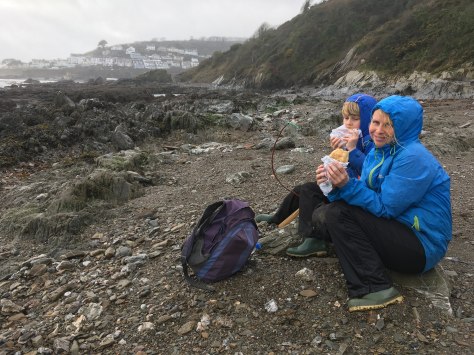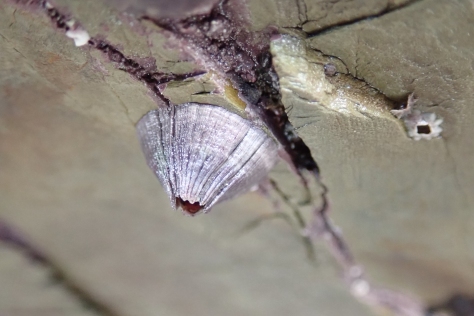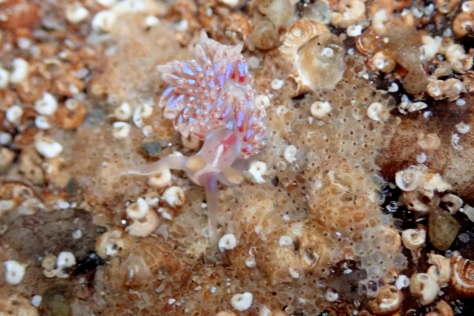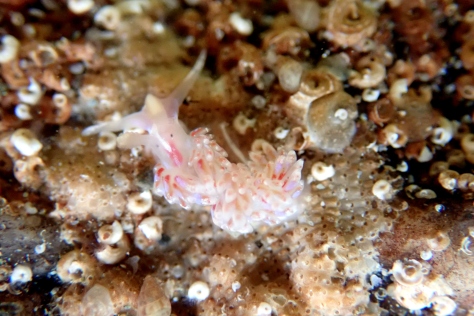Even my family look at me strangely when I suggest rock pooling in this weather. The Met Office reckons it’s going to turn out fine, but the wind is flinging water straight into our faces and the beach is deserted. We huddle down on some damp rocks and rush to eat our pasties before the rain turns the pastry soggy.
“I wonder if people realise what you go through to put pretty pictures on your blog?” Other Half says.
I nod, watching the waves crashing onto the shore and thinking that it’s worse than that. In these conditions I’m unlikely to find much, let alone manage pretty pictures.
Fortunately, I’m wrong.

After a quarter of an hour of staring into holes in the rock, taking lots of rain-blurred photos and a few passable ones of common crab and barnacles species, I’ve established that my waterproofs are anything but waterproof. If it’s possible, the rain is getting heavier.

Cornish Rock Pools Junior and his dad have wandered off and are probably reaching their tolerance limit. I find a stalked jellyfish and think that’s likely to be the most exciting find of the day.

I lift the edge of one last stone. There are some thick yellow sponges and the rock is crusted over with bryozoans. Broad-clawed porcelain crabs are scuttling along and there are little banded chink shells. On the far side is a spot, maybe half a centimetre across. It’s hard to make it out, but it has a blue-ish tinge and a lined appearance, like an anemone out of the water.
I think it’s a sea slug, but it’s far too delicate to pick off the rock and even if I do there’s nowhere to put it. I need to see it in water otherwise it’s just a blob of jelly. There’s no chance of that here at the base of the gully where the waves are pounding in, so I heave the boulder up the shore and lower the side with the slug into the nearest pool.

Shelter’s hard to come by. The surface of the pool distorts with every gust of wind and the rain goes up the back of my coat and into my ears as I lean over to hold the rock in position. Straight away, I know this is definitely a sea slug. In the water, its cerata pop up all over its back and long tentacles and rhinophores unfurl around its head.
This is the sort of colourful, beautiful slug that I’m always hoping to find and only rarely do. Under the camera it has striking red lines and markings up its cerata, white stripes down its head and an iridescent blue sheen that changes as it moves.

This is a new slug to me and I can’t wait to look it up when I get home to check the exact species. In the meantime, I take as many photos as I can before hauling the rock back to the same spot where I found it. That done, I rush up the beach to tell my Other Half, Cornish Rock Pools Junior and everyone else I see that day about how amazing my sea slug was.

Thanks to my pile of identification books and the quick responses of the hugely knowledgeable members of the NE Atlantic Nudibranchs forum on Facebook, I soon have it confirmed as Facelina auriculata (previously known as Facelina coronata).
This slug is found around many coasts of the UK, and is meant to feed on hydroids, although I didn’t see many in the vicinity of this one. I’m very lucky to find it intertidally on such an average tide.
If you think rock pooling isn’t a normal sort of thing to do in January, I can understand that. You’re probably right and I think my family would agree with you, but you never know what’s going to turn up next in the Cornish Rock Pools.
Sometimes it’s worth braving the horizontal rain just in case.





Lovely nudibrach! Down in Penzance we had several nice swims but the sea was so murky, we only saw distant seals and sea birds… Jackie Slipper
Sent from my Samsung Galaxy smartphone.
LikeLiked by 1 person
Thanks Jackie – I hope we get to go out looking for some together soon too. Awful conditions on the shore really, but it just shows you never know. Great that you saw seals. There was a big flock of gannets in Looe today, all diving to catch fish just offshore and fabulous to watch. Keep in touch and we’ll fix some dates x
LikeLike
What a little beauty! I plan to do a lot more rockpooling along the Northumberland coastline this year as sea life just fascinates me. I looked up this tiny sea slug and there HAVE been two records in my county! How exciting!!! To see something so delicate and exotic looking you automatically think ”Oh I doubt they’ll be up here in the North Sea” ….but they are!
Thanks for such a great blog (and congrats on your Local Patch Blogger Award – very well deserved!) and for opening all our eyes to what beauties can be found here in the UK.
LikeLiked by 1 person
Thanks Gillian, it’s a stunner isn’t it! I think it’s absent from south-east England coasts but can turn up almost anywhere else, so fingers crossed! They’re not easy to see out of the water – you’re looking for a tiny spot of jelly on the rock, so it’s worth going slowly and looking very closely. Send me photos if you find one! I’m very excited about the BBC Wildlife Blogger award – it’s lovely to get some recognition for all those hours freezing my fingers off on stormy shores! 🙂 Great tides coming up at the end of next week so I’m hoping more interesting things will show up then. Happy rockpooling! Heather
LikeLike
Wow, what a beautiful and delicate find. It is always amazing to see the delicate forms of life that live in the churning angry seas. I love the line “I wonder if people realise what you go through to put pretty pictures on your blog?” I’m sure that rings true for a few of us posting about the natural world. I was recently reminded of this as I lined up my camera on a hornbill in Panama, only to feel the blistering burn of ant bites. I had stood on their nest. Another lovely post from the coast!
LikeLiked by 1 person
Ouch! Yes, ants are a pain. I lived in Colombia for a while and they were everywhere you might want to sit! Hornbills are fabulous though – all that pain is worth it (hopefully!). Encounters like that are precious moments and I love reading other people’s blogs to get a glimpse of their experiences. Off to have a look at yours now! 🙂
LikeLiked by 1 person
Actually, when I said Hornbill i meant Toucan! Same idea, different continent. 🙂 Wow, Colombia! How exciting!
LikeLiked by 1 person
That makes more sense – Toucan’s are lovely. Hoping to get back to Colombia later this year for a visit – great country. 🙂
LikeLiked by 1 person
Well this certainly makes me feel kinda guilty for not getting out in the recent weather! Such a great find.
LikeLiked by 1 person
I was lucky… 9 times out of 10 I’d have just got soaked and miserable without finding anything much in those conditions. Normally I would avoid going out in the gales, but as they’ve been almost non-stop I didn’t feel like there was much choice but to try. Hopefully the next week will be more settled – I’ll look forward to seeing what you find 🙂
LikeLike